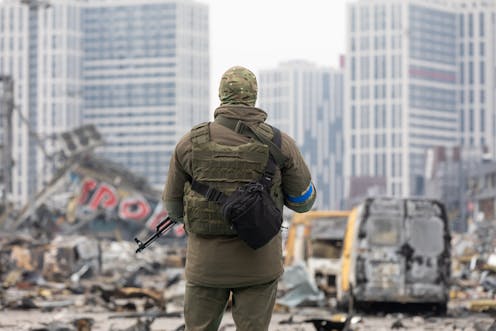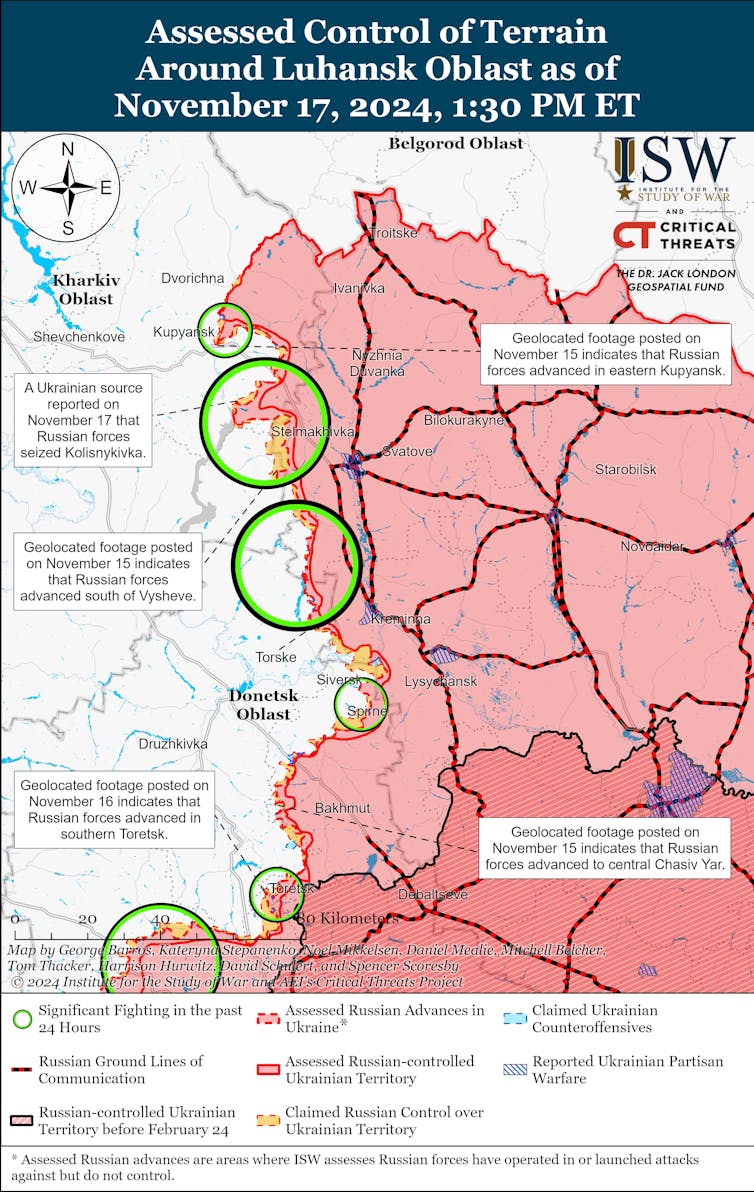Since Donald Trump was reelected on November 5, speculation about what his presidency will mean for the war in Ukraine, which has now entered its 1,000th day, has become frenzied.
It is easy to be sceptical of Trump’s campaign assertion that he would end the war in 24 hours even before taking office in January 2025. But all the signs clearly point in the direction of a serious diplomatic push by Trump to force Moscow and Kyiv to agree on a ceasefire and possibly a broader settlement.
Whatever the outcome of Trump’s dealmaking, it will have consequences that need to be taken seriously and prepared for. From a Ukrainian perspective, the implication is that the country would lose its currently Russian-occupied territories, at least for the time being, and would have to give up on its aspiration for Nato membership. This is highly unpalatable for Ukraine.
However, given recent Russian advances on the front lines in both eastern Ukraine and the Ukrainian-held parts of the Kursk region inside Russia, Kyiv can ill-afford a continuation of the war. This is particularly true if Trump follows through on his threat to cut all military support for Ukraine.
The Ukrainian president, Volodymyr Zelensky, acknowledged as much on November 16 when he said that Kyiv “must do everything so that this war ends next year … through diplomatic means.”
This was partly a nod in Trump’s direction, indicating Ukraine’s willingness to engage in possible US-brokered mediation efforts. But it was also an acceptance that Ukraine’s long-term prospects in the war have been bleak for some time.
The Russian military has been is capturing territory more quickly over the past few months than at any time since the early days of the invasion. Institute for the Study of War
In light of Moscow’s continuing military momentum, there is some doubt that the Russian president, Vladimir Putin, is keen to reach a settlement quickly. He has indicated an openness to negotiations, but Russia is known for dragging talks out, introducing additional demands and conditions, and only signing up to an agreement when it has extracted maximum concessions.
Even then, meaningful implementation on the ground is hardly a given and re-escalation is likely – as the Minsk accords on Ukraine of September 2014 and February 2015 illustrate only too vividly.
A rarely considered third caveat is that, while Trump will probably be fully committed to making a deal initially, he could simply abandon it if his and Putin’s timelines do not align. This is what happened when Trump’s short-lived enthusiasm for an agreement with North Korea’s Kim Yong-un during his first term evaporated, and he simply walked away empty handed.
But, even in this case, some negotiations took place, crucially without much concern for US allies like South Korea and Japan. Ultimately, the non-deal between Trump and Kim became one of the factors that enabled further advances in North Korea’s nuclear programme and a closer relationship between Pyongyang and Moscow.
Regardless of whether Trump pressures Ukraine into a bad deal, Russia defects from a Trump-brokered settlement at a later point, or Trump abandons his efforts to end the war, European allies of both Ukraine and the US must plan for the day after Trump’s inauguration.
This means, above all, taking more responsibility for their own security, as the Polish prime minister, Donald Tusk, put it succinctly before the US elections. This is easier said than done because it is not clear what the trajectory of relations between the key players will be. But several things are clear, and they can provide parameters for European planning now.
What should Europe plan for?
First, the bulk of military support for Ukraine will no longer come from the US. Kyiv’s European allies will have to do most of the heavy lifting in this regard in the future. This will mean providing financing for the purchase of arms and ammunition and investing long-term in Europe and Ukraine’s defence industrial base.
Second, it means supplying Ukraine in a timely fashion with what it needs. However, Ukrainian requirements will need to be aligned with a credible military strategy – not a dreamy victory plan aimed at restoring control over all Russian-occupied territories. This became wishful thinking at the moment Ukraine’s 2023 counteroffensive failed.
What is needed is a viable plan to protect the areas Ukraine will control at the time of a ceasefire, along the front lines and Ukrainian airspace. This will ensure some security against future Russian defection from an agreement, as well as making it more likely that Kyiv-controlled areas can gradually and sustainably be rebuilt.
Third, any military strategy to protect Ukraine will also need to serve as a pillar of a future European security order that reigns in, and credibly deters, future Russian adventurism. That is why Kyiv must not be left to its own devices in future negotiations. In negotiations involving Trump, Putin and Zelenskyy alone, Ukraine would be the weakest link and European interests would probably be completely ignored.
This is not to argue for a return to the format of Russia, Ukraine, France and Germany that oversaw the failed Minsk accords. Rather, if the assumption is that Europe will have to step up and be the main guarantor of Ukrainian sovereignty, Kyiv’s EU and Nato partners need to have some input in negotiations.
The surprise phone call Germany’s chancellor, Olaf Scholz, shared with Putin on November 14 is an indication that this has been recognised.
A European channel of communication will be important to make clear that there is a common understanding of red lines among European partners and of the consequences if the Kremlin were to cross them – as well as the benefits if it were to respect them.
Both consequences and benefits are linked to the western sanctions regime, a point that was driven home by a G7 leaders’ statement in support of Ukraine on November 16, which reaffirmed the “commitment to imposing severe costs on Russia through sanctions”.
Europe will therefore also need to work with Trump and have communication channels into his administration. Scholz’s phone call with Trump on November 10 was reported as a “very detailed and good conversation”, including on Ukraine.
European scepticism of Putin as a reliable partner is at odds with Trump’s vision of cutting a deal with Putin to “un-unite” Russia and China. A common approach to this conundrum across the Atlantic is possible, but it hinges on a feasible and durable settlement concerning Ukraine.
After 1,000 days of the most devastating military confrontation on European soil since the second world war, it is time to accept that nothing about Europe should be without Europe. If it is true that Trump and Putin respect strength and disdain weakness, then the only pathway to getting this point across in Washington, Moscow and Kyiv is through muscular pursuit of European self-interest and self-assertion.



 U.S. Soldiers Killed in ISIS Attack in Palmyra, Syria During Counterterrorism Mission
U.S. Soldiers Killed in ISIS Attack in Palmyra, Syria During Counterterrorism Mission  Hong Kong Democratic Party Disbands After Member Vote Amid Security Crackdown
Hong Kong Democratic Party Disbands After Member Vote Amid Security Crackdown  Global Leaders Condemn Deadly Antisemitic Shooting at Sydney’s Bondi Beach During Hanukkah
Global Leaders Condemn Deadly Antisemitic Shooting at Sydney’s Bondi Beach During Hanukkah  Korea Zinc Plans $6.78 Billion U.S. Smelter Investment With Government Partnership
Korea Zinc Plans $6.78 Billion U.S. Smelter Investment With Government Partnership  Evercore Reaffirms Alphabet’s Search Dominance as AI Competition Intensifies
Evercore Reaffirms Alphabet’s Search Dominance as AI Competition Intensifies  European Leaders Launch International Claims Commission to Compensate Ukraine for War Damage
European Leaders Launch International Claims Commission to Compensate Ukraine for War Damage  Ukraine’s NATO Concession Unlikely to Shift Peace Talks, Experts Say
Ukraine’s NATO Concession Unlikely to Shift Peace Talks, Experts Say  Special Prosecutor Alleges Yoon Suk Yeol Sought North Korea Provocation to Justify Martial Law
Special Prosecutor Alleges Yoon Suk Yeol Sought North Korea Provocation to Justify Martial Law  International Outcry Grows Over Re-Arrest of Nobel Laureate Narges Mohammadi in Iran
International Outcry Grows Over Re-Arrest of Nobel Laureate Narges Mohammadi in Iran  Morgan Stanley Downgrades Tesla as AI Growth Expectations Rise
Morgan Stanley Downgrades Tesla as AI Growth Expectations Rise 

































